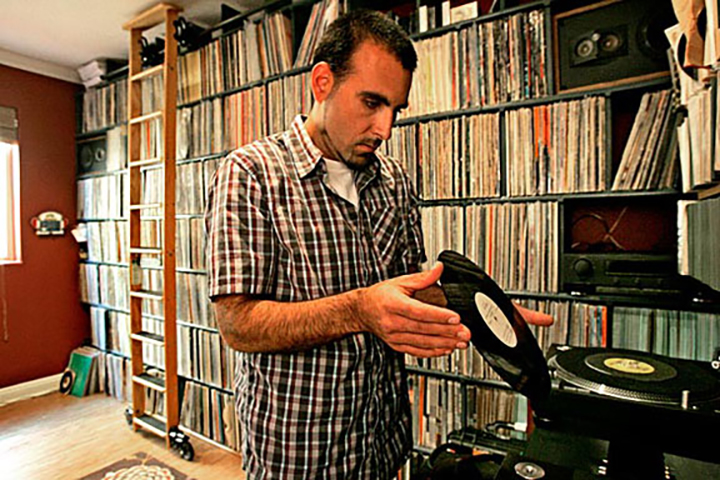Wax Nostalgic: A Chat with Thes One About Old Style Record Jackets
Jun 28th 2011
DoradoPkg recently sat down with Thes One – one half of underground hip-hop act People Under the Stairs – to talk album covers. As one of the most prominent hip-hop artists in Los Angeles, Thes is not only known for PUTS’ unmistakable sound (that combines old school samples with intricate lyrics, recalling the golden-age of hip-hop), he’s also put People Under the Stairs on the map with their unique album covers and vinyl packaging.
Thes took a moment to talk to DoradoPkg about Old Style Tip-On jackets, cover art in general and what’s next for People Under the Stairs.

DoradoPkg: Hey Thes, first of all, thanks for talking to us about Dorado’s newest product offering, Old Style Tip-On jackets.
Thes One: No problem! I’m really excited that one of my favorite presses is getting back into this. The beauty of album art, I feel, is best conveyed on these sleeves and as a record collector they hold up better over time and carry an air of elegance and importance that is often lost with standard sleeves.
DPKG: Definitely; it’s exciting that record jackets are once again an important part of a release. So – first thing’s first. Do you call them Old Style, Tip-On or both? This has been a hot topic at the print shop lately.
TO: I was actually calling them cardboard or thick cardboard sleeves through my life as a collector until my friend Chikara Kurahashi, who runs Tres Records, was asking me about manufacturing “Teppon Sleeves”. So then I called them that for a while as I didn’t know any better and then I thought they were called “Tape-On” sleeves. Needless to say, I’m glad I finally have it right. Anyone who collects records knows what they are and that when the 80’s kind of killed them a lot of the luster of beautifully packaged vinyl went by the wayside for decades.
DPKG: It seems like everyone has their own unique experience with Old Style Tip-On jackets, including what they actually call them! Can you tell us about your experience with Old Style jackets as an artist? Has PUTS released an albums in Old Style jackets before?
TO: We have tried in the past but it’s been very difficult. When Old Style jackets were beginning to be offered again they were cost prohibitive and the turnaround times were sometimes as long as 6 months! So we never were able to venture down that road, it just seemed an unreliable option, until now of course. That said, I always, always wanted to release everything with Tip-On sleeves, I just feel like the music deserves it. We are very fortunate to have this option now for packaging our next double vinyl album this fall.
DPKG: That’s great! You’ve already gone into some detail, but can you tell us what you like about this medium? Do you think it’s better than standard record jackets, or just different?
TO: It’s absolutely better than regular jackets and I say that as both an artist and an obsessive collector. On the artist side, the product has more gravity and literally more weight to it, so it sticks out on a store shelf or in a bin and, in my opinion, the artwork just looks better on these sleeves.
DPKG: Dorado has really perfected that thick, visible spine, especially with the Old Style Jackets.
TO: And that’s great for both the artist and the fan. The consumer gets a great feeling and looking product. The Tip-On has a real spine, a thick tangible area for the title, label info and matrix, one that is legible from afar when the record is shelved in something like the ever popular Ikea Expedit. I love this as a collector. I love that I can scan a shelf and find my record via the spine, if that makes sense. Also, as a collector I love that the thicker cardboard is more resilient to ring-wear and heat damage. And I don’t have to worry about them as much when I ship them or jam them in a record bag for a gig. I just love the feeling of holding a real sleeve.
DPKG: What other ways do you think Old Style jackets add value to an album from a fan perspective?
TO: I feel that vinyl at this point in the game is mostly a collector’s medium. It’s costly; it’s arduous to manufacture, but it is the real deal. And to be able to follow through with a sleeve that matches the boutique aspect of this, I think, is really important when creating collectible products. The consumers care enough to buy vinyl and not download, so I feel obligated to give them a product that lives up to that passion, and Tip-On sleeves are a huge part of that.
DPKG: Given the choice, would you always go for an Old Style jacket over a standard record jacket? Are there any situations where a standard, basic jacket are a better fit for your records?
TO: Well, for things like a 12” single, a standard record jacket is probably the best choice. It can be quicker and more cost effective to produce. But for the full-length albums, the ones where people spend years working on the album and put blood sweat and soul into the product, where you want to see them around 60-70 years down the line on the shelves of collectors and stores, then of course I think there is probably no better way to do that.
DPKG: I feel like once the younger generation catches on to Old Style jackets, they’ll blow up – especially based on how much vinyl is being pressed and sold these days. Do you think part of the Old Style jacket’s appeal is its nostalgia factor?
TO: It definitely has that factor in addition to opening up a lot of interesting graphic and design options that normal sleeves couldn’t accommodate. I’m sure there is going to be a lot of interest once people start seeing them again. The difference is tangible.
DPKG: Do you know much about the history of Old Style jackets? I understand that they became popular in the 60′s right around the time when people started taking album cover art more seriously.
TO: That sounds about right. I know that in certain countries like Cuba, where resources were scarce, it was a crapshoot as to what your cover would be made out of. In Europe a lot of the records had paper sleeves on the outside, sandwiched together. Not a good look. And of all the records I have from the 60’s and 70’s, the vinyl in Tip-On sleeves has held up better than in any other kind of sleeve.
It’s funny because some countries would even recycle used Tip On sleeves by slitting the top and bottom and turning them inside out to reprint. I have lots of records like this, with some other artwork on the inside. I know most of the 80’s and 90’s sleeves that weren’t tip-on have not worn well in my collection over the decades.
DPKG: So tell us about People Under the Stairs’ next project. You’re thinking about Old Style jackets, right
TO: Oh absolutely. It’s titled “Highlighter” and not only are we going Tip-On but we’re trying to get really crazy with it, and we’re stoked to have Dorado helping us take our design and package to the next level.
DPKG: We’re excited to work on it! Anything else you’d like to add before we wrap up?
TO: Nothing other than as a collector and fan of design, I am extremely optimistic about the future of records with this new offering from Dorado!
For more info on Old Style Tip-On jackets or to place your order, visit DoradoPkg’s Old Style Product Page


